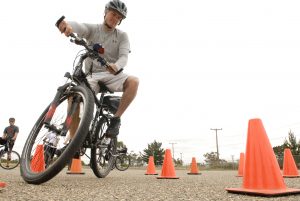We can look through a turn in three different ways:
- By turning our eyes in our heads.
- By turning our head on our torso.
- By turning our torso on our upper body.
![Laurinemily at English Wikipedia [CC BY-SA 2.5 (https://creativecommons.org/licenses/by-sa/2.5)], via Wikimedia Commons](https://ikblijffietsen.nl/wp-content/uploads/2018/06/Hazel-green_eye_2-300x200.jpg)
In cyclists, little is known about turning the torso on the upper body during the turn. In pedestrians, we know more about this: pedestrians first turn their torso in the direction of the turn, then their head (with respect to their torso), and finally their eyes (with respect to their head). Because walking is much more automated than cycling, it is obvious to use the same turning strategy on the bicycle. However, the rotation of the torso is accompanied by a weight displacement in the direction of the turn, so that the bicycle tilts and thus turns. In order to continue straight ahead despite the twisted torso, when approaching the curve the cyclist has to press on the other side of his handlebar for compensation. This requires practice, but then it feels very natural.

Riding a sharp turn is a special situation that deserves separate attention. When riding such a sharp turn, experienced cyclists turn both head and body. The rotation of the torso does not only have to do with the accurate observation of the movement target; the rotation is also enforced by the fact that the handlebars are heavily turned, as a result of which the outer arm is stretched more than the inner arm (see the figure to the right). Riding a sharp turn requires practice, and there are three reasons for this:
- The strong rotation of the torso and the head are unusual movements.
- A sharp turn can only be taken at low speed, and the lower the speed the more unstable the bicycle.
- Cycling with a rotated torso displaces the center of gravity inward, and this tilts the bicycle inwards, especially at low speed. You must therefore adjust the steering impulse to your weight displacement in order to obtain the right tilt.